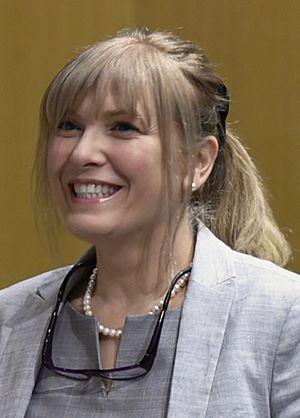C. Marcella Carollo facts for kids
Quick facts for kids
C. Marcella Carollo
|
|
|---|---|
 |
|
| Born |
Palermo, Italy
|
| Nationality | Italian and Swiss |
| Alma mater | Ludwig Maximilian University of Munich (PhD) |
| Known for | Galaxy formation and evolution Extragalactic astronomy |
| Spouse(s) | Simon Lilly |
| Scientific career | |
| Fields | Astronomy Astrophysics |
| Institutions | ETH Zürich Leiden University |
C. Marcella Carollo is a well-known astronomer who worked in science for 25 years, from 1994 to 2019. She is famous for her important work on how galaxys form and change over time. She has held positions at major universities and research centers around the world.
Contents
Education and Early Life
Marcella Carollo started her university studies at the University of Palermo in Italy. In 1987, she earned a degree in physics, focusing on biophysics. After working outside of academia for more than four years, she decided to pursue her passion for space. She began her PhD in astrophysics at Ludwig Maximilian University of Munich and completed it in 1994.
Career Highlights
After finishing her PhD, Dr. Carollo received a special European Community Prize Fellowship. This allowed her to continue her research at Leiden University from 1994 to 1996. She then moved to the United States, where she held a Hubble Postdoctoral Fellowship at Johns Hopkins University from 1997 to 1999.
Becoming a Professor
In 1999, Dr. Carollo became an Assistant Professor in the Astronomy Department at Columbia University. She worked there until 2002. That year, she moved to ETH Zürich in Switzerland, where she became an Associate Professor. She was promoted to a Full Professor in 2007.
Contributions to Space Science
Dr. Carollo was an important member of the Science Oversight Committee. This group helped develop the WFC3 camera, which was installed on the Hubble Space Telescope in 2009. This camera greatly improved Hubble's ability to take amazing pictures of space. Her work helped scientists see even more distant parts of the universe.
Awards and Recognition
Dr. Carollo's scientific contributions have been recognized with several honors. In 2012, she was included in the Top Italian Scientist list by VIA Academy. The following year, in 2013, she received the Winton Capital Research Prize. Her research was highly cited by other scientists, and she was named a Highly Cited Researcher in 2018 for her work at ETH between 2006 and 2016.
Research on Galaxies
Dr. Carollo's main area of research is extragalactic astronomy. This field studies objects outside our own galaxy, the Milky Way. She is especially known for her work on galaxy formation and evolution. This means she studies how galaxies are born and how they change over billions of years.
Discoveries in Galaxy Structure
Early in her career, Dr. Carollo made important discoveries about the structure of galaxies. She showed how the amount of heavy elements (called metallicity) changes within the central parts of galaxies. She also proved that dark matter halos exist far beyond the visible parts of galaxies. Her work was key in finding and describing disk-like "bulges" and huge star clusters at the centers of disk galaxies, like our own Milky Way.
Galaxy Growth and Evolution
Later, Dr. Carollo and her team at ETH Zürich studied how a galaxy's surroundings affect its evolution. They looked at how massive galaxies grow and "stop forming stars" (called "quenching") in the early universe. Her group also helped discover and describe some of the most distant galaxies ever found. These galaxies existed during the reionization epoch, a very early time in the universe's history.

